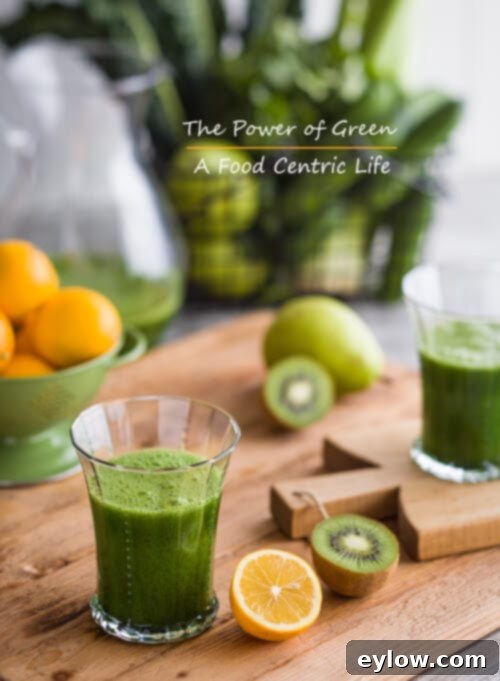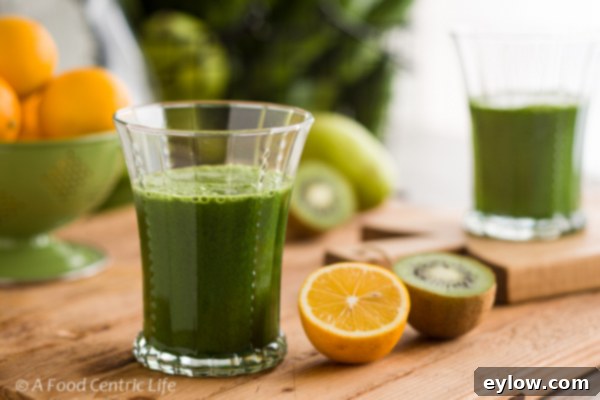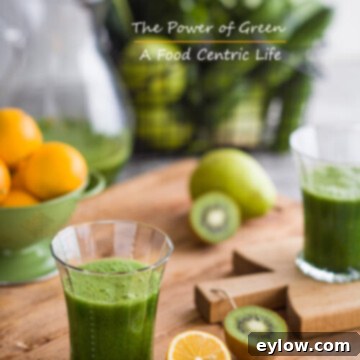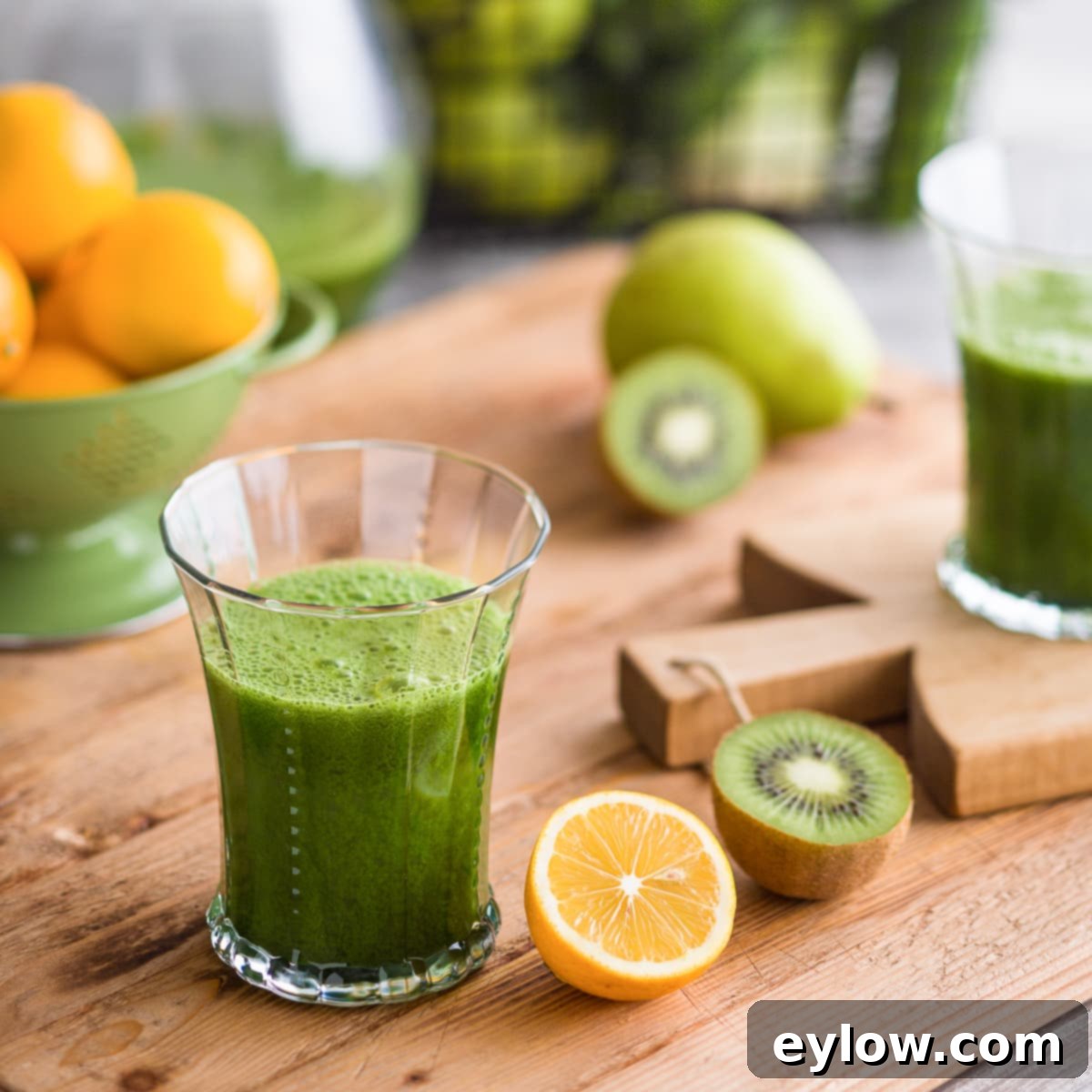Revitalize Your Health: The Ultimate Green Juice Recipe for Detox, Energy & Immunity
Embarking on a journey to better health often starts with small, impactful changes in our daily routines. For many, integrating fresh, nutrient-dense ingredients is a cornerstone of this journey, and juicing offers an incredibly effective way to achieve this. With a state-of-the-art juicer now a staple in my kitchen, I’ve been experimenting with various wholesome juice recipes designed to invigorate the body and mind. This particular green juice recipe, featuring the powerful combination of cucumber and kale, stands out as a true powerhouse of nutrition. It’s a delightful blend of kale, cucumber, pear (or apple), lemon, cilantro, and even a touch of kiwi, crafted to boost your energy, support detoxification, and deliver a significant surge of immune-boosting vitamin C.

The foundation of optimal health lies in a diet rich in fruits and vegetables. These natural wonders are crucial for maintaining wellness and significantly lowering the risk of numerous chronic diseases. While consuming whole fruits and vegetables remains the ideal method due to their invaluable fiber content, meeting the daily recommended intake can often be a daunting challenge for many busy individuals. This is where juicing emerges as an elegant and convenient solution. It provides an effortless way to infuse your diet with concentrated, plant-based nutrition, ensuring your body receives a wide spectrum of essential vitamins, minerals, and phytonutrients without the bulk of whole foods.
Juicing as a Powerful Dietary Supplement
Consider juicing not as a replacement for whole fruits and vegetables, but rather as a potent supplement that enhances your dietary intake. Freshly pressed juices offer a concentrated dose of liquid nutrients that are rapidly absorbed by the body, making them an excellent way to kickstart your day or provide an afternoon energy boost. This rapid absorption means your body can immediately utilize the beneficial compounds, supporting everything from digestive health and a robust immune system to improved cellular function. It’s important to remember that while juicing extracts most of the fiber, this doesn’t diminish its value. It simply means you should continue to prioritize whole fruits and vegetables in your meals to ensure adequate fiber intake, which is vital for digestive regularity and satiety. Juicing simply complements this, providing a fast-acting nutrient delivery system.
Unlocking Nature’s Pharmacy: The Potent Ingredients in Your Green Juice
The term “Nature’s Pharmacy” couldn’t be more fitting when describing the incredible healing and protective properties found in fruits and vegetables. Or, as some cleverly put it, “Nature’s Farmacy.” These vibrant ingredients are meticulously packed with a diverse array of vitamins, minerals, and powerful phytonutrients – compounds that act as formidable tools in combating disease and promoting longevity. We simply cannot consume enough of them in our daily lives, and juicing provides an efficient way to significantly boost your intake. Each component of this green juice recipe brings its unique set of benefits, working synergistically to enhance your overall well-being:
- Kale: Often hailed as a “superfood,” kale is an exceptional source of Vitamins A, C, and K, along with numerous antioxidants like quercetin and kaempferol. These compounds help our bodies combat oxidative stress, reduce inflammation, and support cellular detoxification, making it invaluable for flushing out environmental toxins from pesticides, heavy metals, and air pollution.
- Cucumber: Composed of about 95% water, cucumbers are incredibly hydrating. They also contain silica, which is beneficial for skin health, and a range of B vitamins, Vitamin C, and electrolytes. Cucumbers offer anti-inflammatory properties and contribute to overall body cleansing, assisting in the removal of metabolic waste.
- Pear (or Apple): Adding a touch of natural sweetness, pears and apples are rich in antioxidants, particularly vitamin C, and various polyphenols. They support cardiovascular health and can contribute to a healthy gut microbiome due to their natural sugars and gentle nature, even when juiced.
- Lemon: A citrus powerhouse, lemon is a fantastic source of Vitamin C, known for its immune-boosting and powerful detoxifying capabilities. It helps alkalize the body, aids digestion, and adds a bright, refreshing flavor that balances the earthiness of the greens. The limonene in its peel (which can be juiced if your juicer manual permits for Meyer lemons) acts as an antioxidant.
- Cilantro: This aromatic herb is more than just a flavor enhancer; it’s a potent detoxifier. Cilantro is widely recognized for its ability to help chelate heavy metals from the body, supporting a deeper cleanse. It also provides a unique blend of antioxidants and has anti-inflammatory properties.
- Celery: With its high water content and natural electrolytes, celery is excellent for hydration. It contains powerful anti-inflammatory compounds, supports digestive health, and can help regulate blood pressure.
- Kiwi: A small but mighty fruit, kiwi is brimming with Vitamin C (even more than oranges!), Vitamin K, and Vitamin E. It’s also known for its digestive enzymes, such as actinidain, which aids in protein breakdown, making it a wonderful addition for enhanced nutrient absorption.
Together, these ingredients make this green juice an elixir that:
- Actively helps our bodies flush out environmental toxins.
- Delivers a potent vitamin C punch for robust detoxifying and cleansing.
- Significantly improves circulation, thoroughly supports digestion, and enhances cardiovascular health.
- Boosts brain function, helping to reduce the negative effects of stress.
- Provides significant anti-aging and anti-inflammatory benefits, contributing to cellular regeneration.
- Offers a natural, sustained energy boost without the jitters associated with caffeine.
The Undeniable Advantages of Juicing at Home
While convenience stores may offer a variety of “green juices,” many commercial options come with hidden pitfalls, often containing added sugars, artificial flavorings, and preservatives that detract from their purported health benefits. The superior choice is always to make your juices at home. By preparing your own green juice, you gain complete control over the ingredients, ensuring you’re using fresh, high-quality produce, ideally organic, to minimize pesticide exposure. This personalized approach guarantees that your body receives the purest form of plant-based nutrition possible. Furthermore, the nutritional potency of freshly made juice is at its peak immediately after extraction. As juice sits, even for a short period, its delicate vitamins and enzymes begin to degrade. Therefore, to harness the maximum nutritional power, it’s crucial to drink your homemade green juice as soon as possible after juicing.
Juicing Versus Blending: Understanding the Key Differences
Both juicing and blending are excellent methods for incorporating more fruits and vegetables into your diet, and I personally embrace both for different reasons. They are distinct processes that offer unique benefits. Understanding these differences can help you decide which method is best for your specific health goals.
- Juicing: This process separates the liquid content from the insoluble fiber (pulp) of fruits and vegetables. The result is a highly concentrated, nutrient-dense liquid that is incredibly easy for your body to digest and absorb. Because the fiber is removed, the nutrients enter your bloodstream very quickly, providing a rapid infusion of vitamins, minerals, and enzymes. This makes juicing ideal for a quick energy boost, detoxification protocols, or when you need to give your digestive system a rest. However, without the fiber, juices can cause a quicker spike in blood sugar, especially if high-sugar fruits are used excessively.
- Blending: In contrast, blending processes the entire fruit or vegetable, including all its fiber, into a smoothie. This means you consume the whole food, retaining all the dietary fiber. Fiber is essential for digestive health, promoting satiety, regulating blood sugar levels, and contributing to a healthy gut microbiome. Smoothies tend to be thicker and more filling than juices, making them a great meal replacement or a substantial snack. The presence of fiber slows down the absorption of sugars, leading to a more gradual energy release.
So, which is better? Neither is inherently “better”; they simply serve different purposes. If you’re looking for a quick, concentrated nutrient hit and want to give your digestive system a break, juicing is an excellent choice. If you prioritize satiety, a slower release of energy, and the comprehensive benefits of dietary fiber, blending is ideal. Many health enthusiasts, including myself, incorporate both into their routines to enjoy the full spectrum of benefits that fresh produce has to offer.

Important Health Notes: Consult Your Practitioner
While this green juice is packed with incredible health benefits, it’s crucial to be mindful of certain individual health conditions. If you have thyroid issues, it is highly recommended to consult with your healthcare practitioner about consuming raw kale. Goitrogens, naturally occurring compounds found in cruciferous vegetables like kale, can potentially interfere with thyroid function in some individuals, particularly when consumed in large quantities and raw. Lightly steamed kale, rather than raw, may be a more suitable option in such cases, as cooking can reduce the goitrogenic compounds.
Additionally, if you are currently taking blood-thinning medication (anticoagulants), it is absolutely imperative to discuss the consumption of kale with your doctor. Kale is exceptionally rich in Vitamin K, a nutrient vital for blood clotting. A sudden increase in Vitamin K intake can interact negatively with blood thinners, potentially compromising the effectiveness of your medication. Always prioritize professional medical advice when making significant dietary changes, especially if you have existing health conditions or are on prescription medication.
Expand Your Juicing Horizons: More Green Juice Recipes to Explore
If you’ve fallen in love with the invigorating taste and myriad benefits of this green juice, there’s a whole world of verdant concoctions waiting to be discovered. Expanding your repertoire of green juice recipes is a fantastic way to introduce new nutrients and flavors into your diet. I encourage you to try these other refreshing and health-boosting blends:
- For a uniquely bright and earthy flavor profile, try the refreshing Celery Fennel Green Juice.
- If you’re seeking a deeply cleansing and purifying experience, the Clean Green Cabbage Celery Juice is an excellent choice.
- And for an all-encompassing detox, don’t miss the powerful and restorative Dandy Detox Green Juice.
Each recipe offers a different symphony of flavors and a unique combination of nutrients, allowing you to tailor your juicing experience to your specific needs and preferences. Happy juicing!
📖 Recipe

Cucumber Juice with Kale and Lemon
Sally Cameron
Yield: about 1 quart (1 liter)
Pin Recipe
Ingredients
- 1 green pear or green apple
- 4 Persian cucumbers or one English cucumber
- 4 large celery ribs
- 8 leaves green kale
- 1-2 lemons
- ½ bunch cilantro
- 1-2 kiwi
Instructions
-
Wash all produce thoroughly under cold running water. Prepare your fruits and vegetables by cutting them into appropriate sizes for your juicer. Follow your juicer manufacturer’s directions for processing.
-
Once juiced, whisk the juice together gently if needed to ensure all ingredients are well incorporated. Serve and enjoy immediately for optimal nutrition and the freshest taste.
